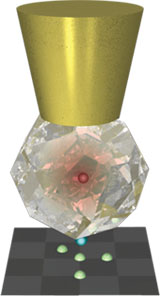Highlights
Proposal holds promise for imaging atoms by their nuclear magnetic field: paper in Phys Rev Lett
Atomic force microscopes can map the surface of materials atom by atom, but even more could be learned from probes that can see the magnetic field of the atoms' nuclei. Researchers at CQT and the University of Oxford, UK, have proposed a device that could achieve the required sensitivity.
The work published 10 November in Physical Review Letters is highlighted by the journal as an "Editor's Suggestion" and featured in the online magazine Physics.

The proposed magnetic sensor would consist of a diamond containing an NV centre (shown red) attached to the tip of an atomic force microscope. The device's sensitivity is enhanced by an 'amplifier' spin system (blue) on the surface of the diamond, where it is close to the target atoms (green).
Typically an AFM probes the distribution of electrical charge around an atom. Measuring individual nuclear fields would more precisely locate atoms and help to distinguish one type of atom from another. (The nuclear magnetic field arises from the nuclear spin – a quantum-mechanical property that differs from one atom to another.) Applications would include determining the structure of molecules deposited on a surface.
"This would allow us to see the full nature of an atomic structure, much as colour photography reveals far more than black and white," says Simon Benjamin, one of the authors of the paper and a Visiting Research Associate Professor at CQT. He and his collaborator Erik Gauger, a CQT Research Fellow, are also affiliated with the University of Oxford, where other co-authors Marcus Schaffry and John Morton are based.
A first step is being made by experimental groups working to build magnetic sensors based on 'NV centres' in diamond crystals. NV centres are where a nitrogen atom appears in the diamond's carbon structure next to a missing carbon atom. Protected by the surrounding diamond, the NV centre has a long-lived quantum state that can be used to sense magnetic fields. Such a diamond could be attached to the tip of an AFM probe and the state read by laser pulses.
The problem is that having the NV centre embedded in diamond necessarily puts it a certain distance from the sample. There's a trade-off: further from the sample the magnetic field is weaker and therefore harder to resolve, but shrinking the diamond decreases the lifetime of the state used in the detection.
What the Singapore and Oxford researchers have come up with is a way to subvert this trade-off. They propose attaching an 'amplifer' spin system such as a molecule to the tip of the diamond (see graphic). The amplifier interacts with the sample and with the NV centre — transmitting a measurement of the magnetic field from the diamond tip to the NV centre from where it can be read. Because the amplifier system is closer to the surface than the NV centre, the combined system is 100 to 1000 times more sensitive than the NV centre alone, according to the researchers' calculations.
The researchers calculate that an amplified-NV-centre sensor could resolve the magnetic field of individual protons measured from a distance of one nanometer.
"The central idea of paper, i.e. utilising an extra spin that is much closer to the sample than the NV centre can be, is actually a very simple and natural idea, one might almost say a 'no-brainer'. Our paper then delivers the detailed and rigorous calculations to back this idea up and analyse how well such an amplified sensor system can be expected to work in practice," explains Erik.
In practice, attaching an amplifier system to a diamond sensor is a challenge on top of the challenge of building the sensor in the first place. About the experimental teams developing NV-centre-based sensors, Erik says "we would expect to see first prototype devices in the next few years. We certainly hope that our paper will give them motivation to add the amplifier spin to their devices as soon as they manage to get the basic system working!"
For more details, see the paper "Proposed Spin Amplification for Magnetic Sensors Employing Crystal Defects" Phys. Rev. Lett. 107, 207210 (2011); arXiv: 1104.0214.
Coverage in the media:






